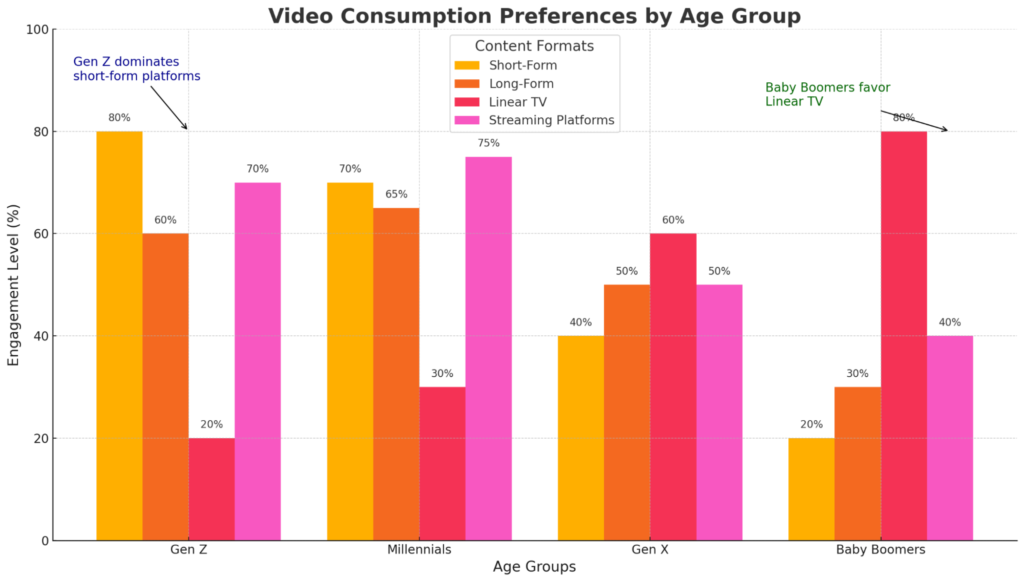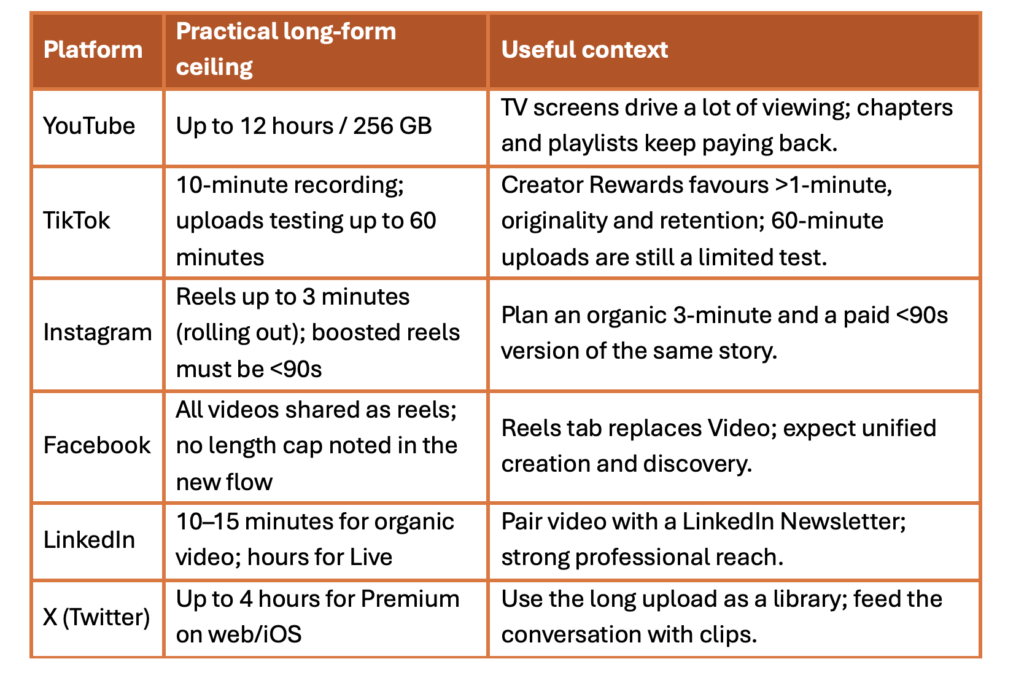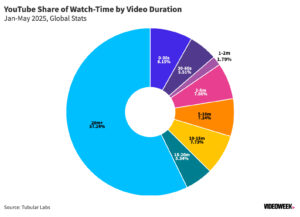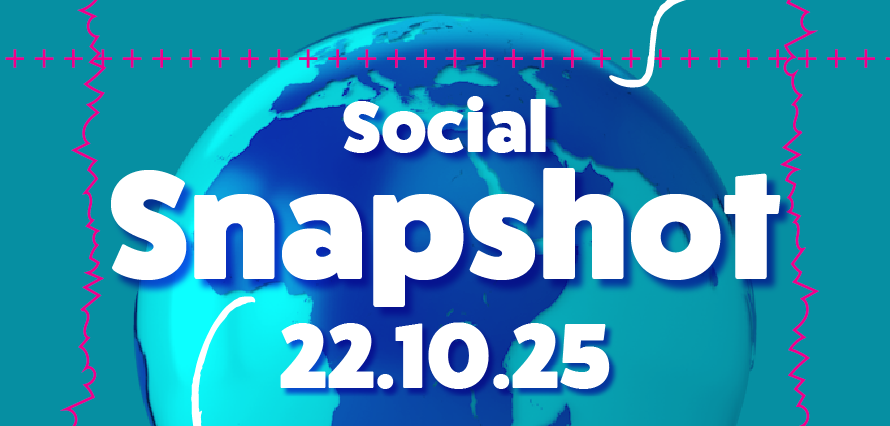October 22, 2025
Long-form is having a social moment
Have you noticed the trend to long-form in social? Maybe it’s creeping up on us rather slowly. But if you look at the numbers, it is there.
It seems audiences are staying for the deeper content. And this is your opening to build trust, spark search and drive sales. The figures say so; the product updates prove it. YouTube is now a living-room habit; TikTok is paying creators for videos over a minute; Instagram has opened the door to three-minute reels, and it goes on. This is good news for anyone selling considered products, complicated services, or a change in behaviour; you finally have room to prove it in-feed.
What’s actually changed
- Viewing has shifted to TV screens. YouTube reports 1+ billion hours watched daily on TVs; Nielsen’s Gauge shows streaming hitting record share in May and July 2025, with YouTube leading media distributors.
- TikTok ties money to time with its Creator Rewards scheme which focuses on originality, videos over one minute, play duration and search value, explicitly rewarding retention. More on TikTok video length at https://immediatefuture.co.uk/blog/how-long-should-your-tiktoks-be/
- Instagram lengthened Reels to three minutes (rolling out now), confirmed by the Instagram Creators team and Adam Mosseri. You can still only boost Reels under 90 seconds, so plan an organic cut and a paid cut.
- Facebook is simplifying video. All new uploads will be shared as Reels and the Video tab will become Reels; Meta says longer videos will be supported.
- LinkedIn is built for deep content from the get‑go: organic video posts support up to 10–15 minutes, and newsletters now exceed 500m subscriptions.
- X will host the long cut if you need it: Premium users can upload up to 4 hours on web and iOS; Android currently caps at 10 minutes.
How long-form social content helps marketers
Brands benefit significantly from using long‑form social video content because it builds deeper engagement, trust and meaningful connections with audiences. Unlike short‑form, long‑form gives you the time and space to tell richer stories, demonstrate products in detail, and fully explain complex topics, which lifts credibility and authority.
Think webinars, how‑to sessions, little behind‑the‑scenes series and a sponsored run that feels like a proper programme. You’re telling a story and keeping the chat going; modern viewers lean in because it feels human, not a promo. Long‑form also shines for live moments and community events; the comments, the questions, the back and forth all deepen engagement and start a relationship that lasts.
Keep an eye on signals that matter: completion, average view time, saves, and the lift in assisted conversions.

And of course, the win is bigger when you blend it with short clips. You can see how quick clips spark interest and drive people to the full piece, then the full piece does the heavy lifting. Keep that rhythm going and you’ll see steadier results month after month.
How to adjust the strategy for long-form
Think in series.
Pick one buyer problem per series and give it a reliable format and cadence. Build chapters; signpost what’s coming so people settle in and stay. Seed discovery with clips; Shorts and teaser reels should carry one clean idea and a reason to continue.
Treat titles, descriptions and captions like search answers; TikTok’s Creator Rewards makes this worthwhile and YouTube chapters keep paying back in search. Keep a paid‑ready cut on hand; Instagram’s boost limit under 90 seconds won’t change on the week you need it. Then judge success with grown‑up metrics (completion, average view duration, saves and assisted conversions) rather than a single view count screenshot.
And because every category behaves a little differently, shape the series to fit (I spent a wee bit of time to pull this together for you):
- B2B tech and SaaS: go deep with 8–12 minute product walk‑throughs, customer interviews and “how it actually works” sessions. Pair each episode with a LinkedIn Newsletter for reach in inboxes; LinkedIn reports hundreds of millions of newsletter subscriptions, which is gold for decision‑makers who like to read and save.
- Retail and ecommerce: comparison videos, care guides and creator try‑ons in the 3–10 minute range work well; use short cut‑downs to route shoppers to the full piece where the proof lives. TikTok rewards videos over a minute, so structure chapters and let the detail do the selling.
- Health, fitness and wellness: classes, routines and evidence‑based tips thrive in longer formats; tutorials rank among the most watched categories weekly across social. Keep the tone friendly, add clear on‑screen steps and captions for silent viewing. GWI stats
- Financial and professional services: chaptered explainers ease anxiety and build trust. Use 6–10 minutes to unpack choices, risks and fees; publish transcripts for search and accessibility, then clip the key answers for Shorts and Reels.
Keep it warm, keep it useful, and keep the cadence steady; the mix of short clips for discovery and longer pieces for proof is where the compounding results live.
Long-form social video platform specs and paid limits

What to tell the board, simply

You can reach people in the living room now, not only on the phone; YouTube’s share of TV viewing keeps hitting highs, and UK viewing shows more time on TV sets. See Nielsen’s Gauge for May’s record 44.8% streaming share and Ofcom’s Media Nations 2025 for UK trends. If the audience is willing to watch for longer, the job is to give them something worth watching and make sure the short clips act like doorways to it.
Measurement that protects budget
Set some light guardrails for each series. Aim for at least half your viewers to reach the mid‑point, keep an eye on average view time, and note the saves.
In the week you publish, look for a lift in branded search; it’s a useful proxy for intent. Then give yourself a fair test: compare accounts that saw the episode with a matched group that didn’t and watch the assisted conversions and pipeline touches. It’s not glamorous work, but it settles arguments at the table.
The proof lives in the quality of attention and what happens next; the return visit, the save, the search, the enquiry. And if you need a friendly stat for the finance team, Wyzowl’s 2025 study found 93% of marketers see good ROI from video (source).
Where a bit of craft still makes the biggest difference
Let’s talk craft, because this is where long‑form earns its keep. Open strong, then settle; the first ten to thirty seconds buy you the rest. Keep the promise your title and thumbnail make and get to the point quickly; YouTube’s retention tools even show your “intro” percentage for the first 30 seconds so you can see if people stay or slip away.
Build clear beats. Promise, proof, payoff. Use on‑screen chapter cards and timestamps so people can hop to what they need; chapters keep paying back in search and help viewers on TV apps scrub less and watch more
Mind the pace. Cut a little quicker in minute one, then let the detail breathe. Don’t panic if average engagement drops as length grows; Wistia shows that while longer videos often have lower engagement rates, they can deliver more total watch time, and instructional pieces in the 3–5 minute pocket can hit standout engagement (Wistia stats, insight).
Design for how people actually watch. Many view on mute, especially in feeds, so add captions that are easy to read and a tidy transcript for search. Keep text large, high‑contrast and well-spaced. Little pattern breaks help too; a cutaway, a graphic, a quick demo.
Keep it useful, interesting or entertaining; ideally two of the three. A tiny reveal every minute keeps attention honest. Show the real thing working, bring in a customer voice, and leave space for a human moment; it’s social, not a manual.
Now the written side. Put a short answer up top, then let the story unfold. Make it scannable with sub‑headings, bullets and callouts; Nielsen Norman Group has banged this drum for years and the results still hold, with scannable layouts improving comprehension and engagement for 1,000‑word‑plus reads. Chartbeat sees engaged time rise with word count up to a point; long pieces can work beautifully when they’re structured and worth the time.
Make it answer‑engine friendly while you’re there. Start with a clean 80–120‑word answer, use question‑led sub‑headings, add a short FAQ, and publish transcripts and chapters with descriptive labels. Mark up pages and videos with the right schema so AI and search can lift the good bits; CXL, Surfer and HubSpot all point to the same habits for AEO success (direct answers, entity‑rich headings, structured data, and internal links). And remember TikTok’s own wording includes “search value” in its rewards formula, so the way you title, caption and chapter matters for discovery as well as retention.
The platforms have made room for grown-up stories again.
Take it.
Pick one series, keep the cadence steady, measure the right things, and let the short clips do the inviting. If you want a quick audit of topics, formats and cuts we’d prioritise first, reply and we’ll map it out with you over a cup of tea.
